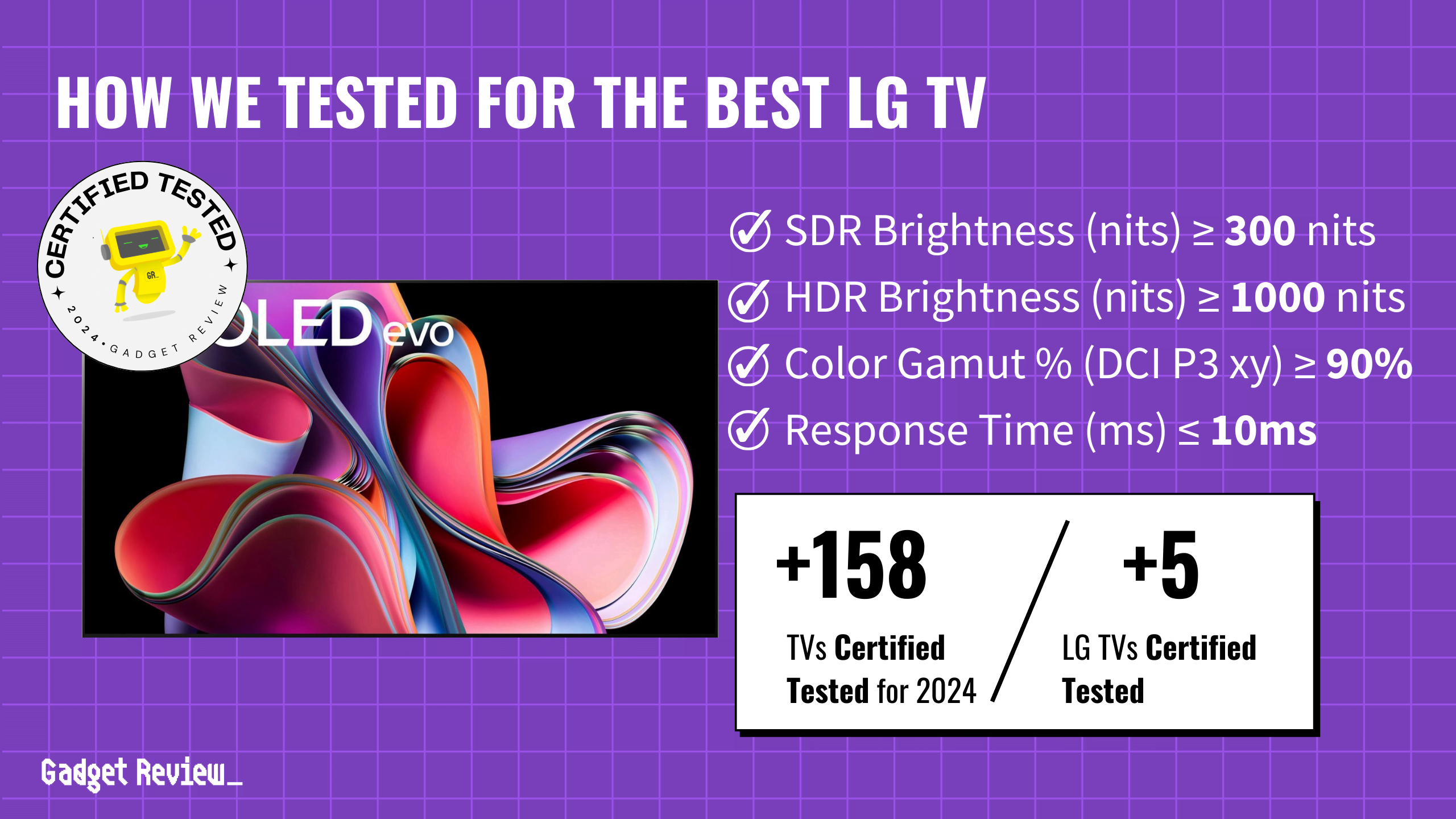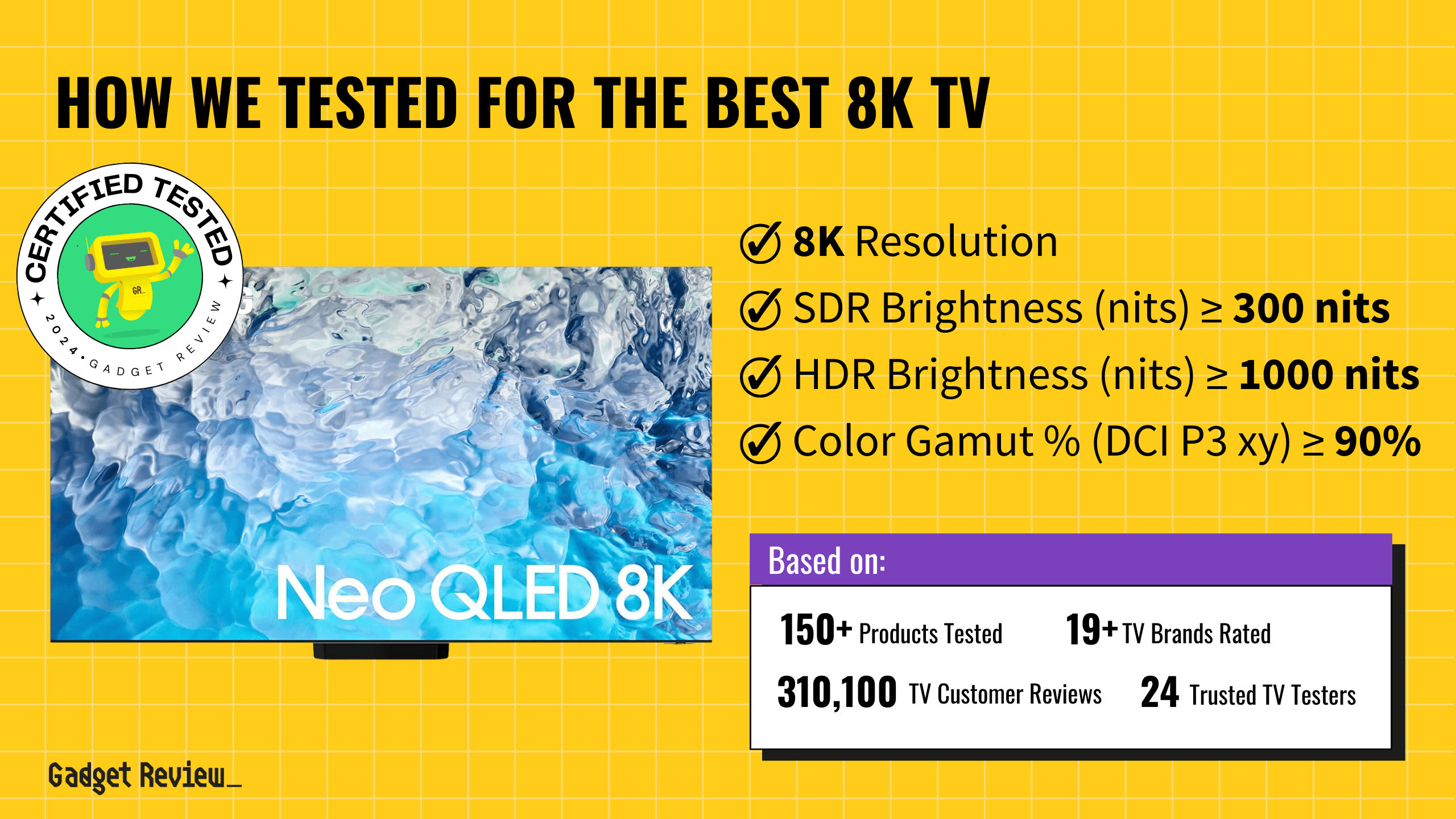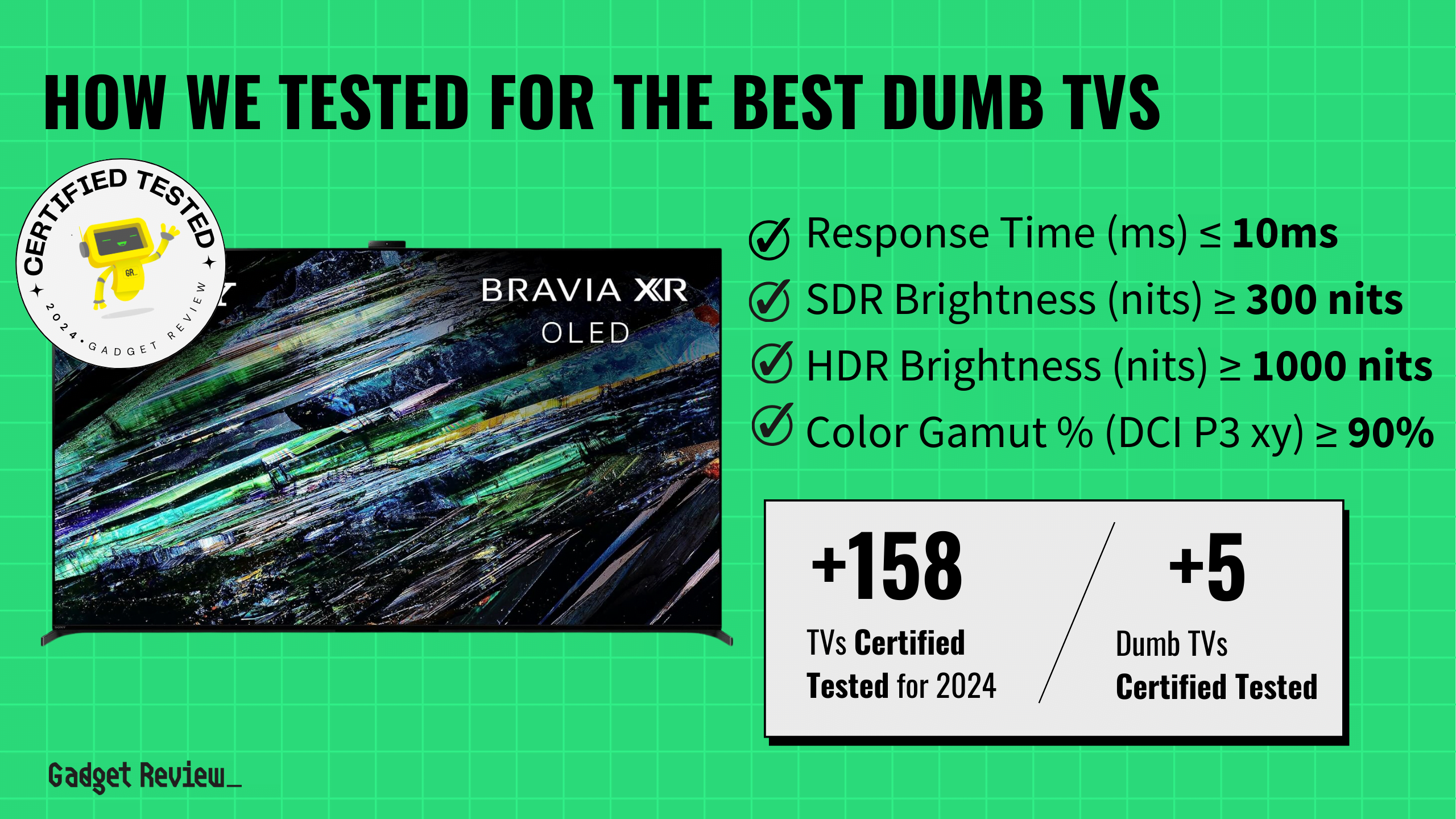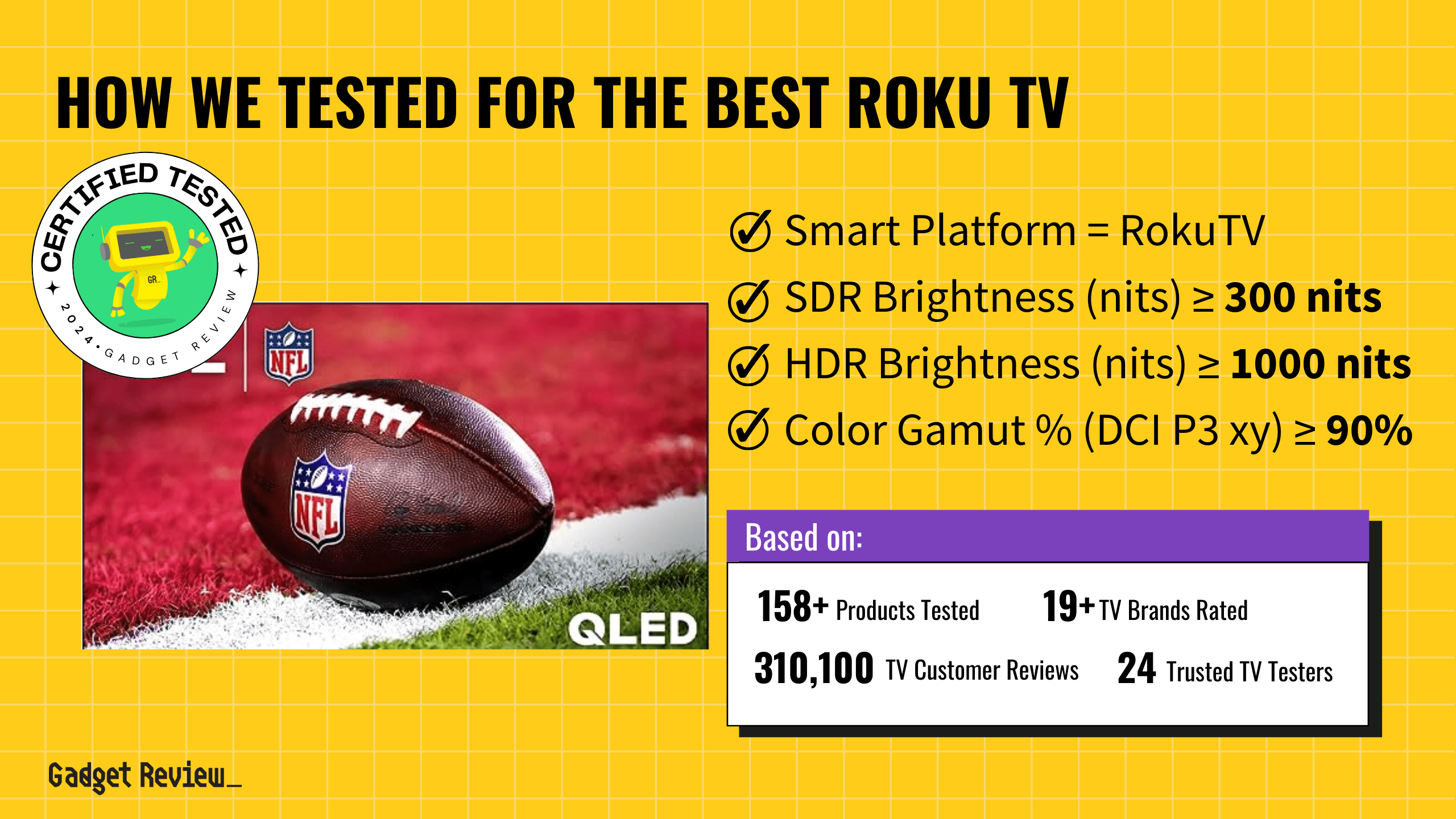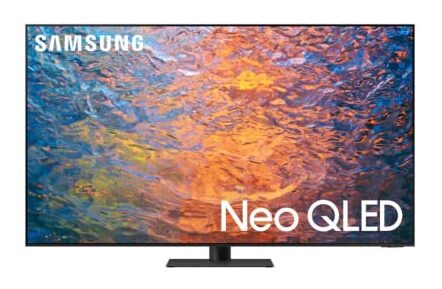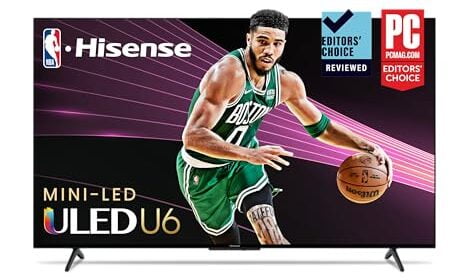The best LG TVs are their OLED models, which outperform their LED and microLED counterparts in quality and versatility, especially for uses like gaming and movies. LG has been instrumental in advancing OLED technology, setting a high bar for picture quality and viewer experience.
While LG also offers LED and microLED sets suitable for tighter budgets, these don’t match the OLEDs’ performance. When considering the best TVs on the market, LG’s OLED options consistently top the lists due to their exceptional color accuracy, deep blacks, and high contrast ratios. Therefore, we recommend opting for an LG OLED TV if your budget permits, to ensure the best viewing experience across all types of content.
How Did We Rank the Best LG TVs?
To assess how high or low quality an LG TV actually is for your content, one must evaluate specific testing criteria against reference industry standards. Using our thorough TV Testing Methodology, we determined there are 6 criteria below (3 required, 3 nice to have) that ensure your 4K content looks as good as the creator intended it.
? Test Criteria
- SDR Brightness: Achieving a minimum of 300 nits, ensuring optimal visibility and clarity irrespective of ambient lighting conditions.
- HDR Brightness: A threshold of 600 nits or above, unveiling intricate details in high dynamic range content with exceptional clarity.
- Color Accuracy: Meeting or exceeding 90% coverage of the DCI P3 color gamut, delivering vivid and lifelike colors.
? “Nice To Haves”
- Contrast Ratio: Attaining a ratio of 10,000:1 or higher, presenting deep blacks and bright whites for an immersive viewing experience.
- EOTF Accuracy: Maintaining a Delta E value of 0.018 or less, ensuring precise rendition of brightness and contrast throughout.
- Fast Response Time: Achieving a response time of 10ms or less, guaranteeing smooth transitions devoid of motion blur.
We’ve redefined TV buying guides, setting us apart from any other site on the planet. Our unique approach combines in-house verification with a comprehensive dataset from over 200+ trusted sites, focusing on key testing metrics to rank the top-rated LG TVs. Testing data and specs include SDR brightness of at least 300 nits, HDR brightness of 600 nits and above, and color accuracy with a minimum of 90% DCI P3 color gamut. We aggregate and analyze this data from 158+ TVs, ensuring our recommendations meet your specific needs. For the best LG TV, this means delivering unparalleled resolution, exceptional brightness and color fidelity for an immersive viewing experience. Our commitment to unbiased reviews is powered by our ‘True Score’ system, targeting low quality and fake reviews. Commissions fund this mission. No bias. No BS.
Latest Updates
- 03/21/2024: Completely and thoroughly overhauled the guide to include the best and latest LG TVs.
- 11/30/2023: Republished the list to include TVs based on our True Score system.
Top LG TVs For 2025
Prices accurate at the time of publishing
To earn a spot on our list, an LG TV must have exceptional image quality and color accuracy. If they don’t meet these requirements, they will not be considered.

Best Overall

Runner Up

Best Value

Best Budget

Best Mid-Range

Premium Pick
LG G3 OLED TV
Best For Home Theater
The LG G3 excels in brightness and viewing angles, making it a top choice for diverse lighting conditions and group viewing, despite its premium cost.
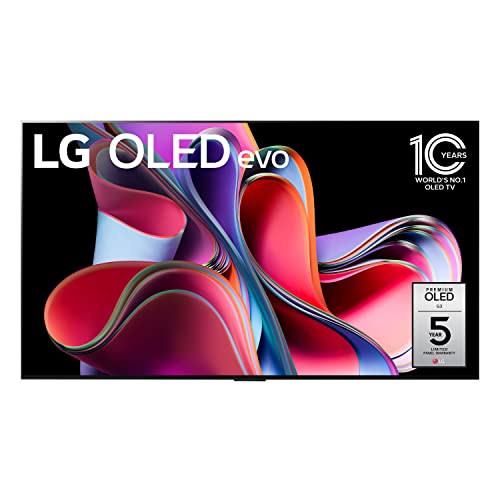
True Score
909315Experts
923kCustomers
Cosmic Wonder
 SAVE $950$2,796.99$1,846.95
SAVE $950$2,796.99$1,846.95Snapshot
Reasons to Buy
- Excellent picture quality
- Near-infinite contrast ratio resulting in perfect blacks
- Extremely bright for an OLED
- Fast motion handling
- Exceptionally wide viewing angle
Reasons to Avoid
- Aggressive automatic brightness limiter
- Subpar sound quality
Specifications
Max Resolution 3840 x 2160 (4k) 
Backlight Type n/a Refresh Rate 120 Hz Display Type OLED HDMI Inputs 4 
HDMI Type HDMI 2.1 HDR Format Dolby Vision, HDR10, HLG 
HomeKit Compatible Yes 
Number of Audio Channels 4.2 
Panel Type OLED Screen size 55″, 65″, 77″, 83″ 
Smart Platform webOS 
Speaker Output 60 watts 
Sync Technology G-Sync 
VRR Yes All Specs
Test Results
SDR Brightness (nits) 503 HDR Brightness (nits) 1,385 Color Gamut % (DCI P3 xy) 97.5457 Response Time (ms) 2.6 Contrast Ratio (x:1) 0 EOTF (600 nit delta) 0.0027 Color Gamut % (DCI P3 uv) 99.13 Color Gamut % (Rec 2020 xy) 73.65 Color Gamut % (Rec 2020 uv) 75.48 Color Gamut % (sRGB) 100 Color Gamut % (Rec 709) 99.7631 Color Gamut % (BT.2020) 74.4 Color Gamut % (Adobe RGB) 94 Color Gamut % (BT.709) 0 Input Lag (ms) 11.8 Color Washout (Degrees) 70 Color Shift (Degrees) 70 Brightness Loss (Degrees) 70 Reflections (%) 0.9 Low-Freq Extension (Hz) 89.8 Freq Response StdDev @ 70db 2.01 Freq Response StdDev @ 80db 2 Weighted Total Harmonic Distortion @80db 0.143 Intermodulation Distortion @80db 1.4 EOTF (1000 nit delta) 0.0039 EOTF (4000 nit delta) 0.0036 All Tests
All Retailers
- $1,846.95$2,797Save $950
Availability
In StockFree Shipping
No - $1,996.99$3,297Save $1
Availability
In StockFree Shipping
- $2,899.00$3,300Save $401
Availability
In StockFree Shipping
No
Our Verdict
The LG G3 OLED TV earns its spot as one of LG’s top models thanks to its overall performance across the board, though it also has a price tag to match. While its 97.55% DCI P3 xy color gamut coverage is lower than the B3 or C3, it barely trails both of them. It also makes up for the slightly reduced gamut with its SDR and HDR brightness levels of 503 and 1385 nits, respectively.
This brightness puts the G3 well ahead of both TVs and makes it capable of performing well under both low and high ambient light conditions. No other LG TV on our list can come close to matching the raw brightness output of the G3. Additionally, its low reflection percentage (0.9%) ensures that the screen remains visible and minimally affected by ambient light, enhancing the viewing experience across various environments.
If you’re more interested in gaming, the LG G3’s low input lag of 11.8 ms and fast response time of 2.6 ms make it suitable for fast-paced content without noticeable delay, though the C3 edges it out in both categories. However, if you have frequent parties, the G3’s viewing angles are unmatched, coming at 70 degrees before color washout starts.
On the other hand, if you’re looking to get the most out of home theater and HDR content, the best in class EOTF of 0.0027 means that the G3s gamma accuracy is phenomenal, keeping content as close to the intended mastering as possible.
Despite the high price tag, the G3’s excellently suited for a range of applications beyond traditional TV watching. Its performance in critical areas like color accuracy, brightness, and low latency makes it a versatile option suitable for gaming, watching in different lighting conditions, and enjoying high-quality content.
Category Snapshot
TVs
- Total Brands/Products Tested
17 Brands, 158 Products
- Top 2 Brands
LG, Hisense
- Price Range (Budget-Premium)
$400-$2000
- Average True Score
76.65
- Important Test Criteria
Brightness (cd/m2)
Contrast Ratio (1000:1) - Most Trusted Testers

- Top TV Experts
- Recommended Retailer

- Typical Warranty
1 year
- Covered by Insurance
Yes – AKKO
- Test Methodology

Best Overall

Runner Up

Best Value

Best Budget

Best Mid-Range

Premium Pick
LG Flex OLED TV
The Flex’s unique bending screen offers unmatched immersion for gaming and movies, justifying its premium for niche needs despite its size and brightness limitations.
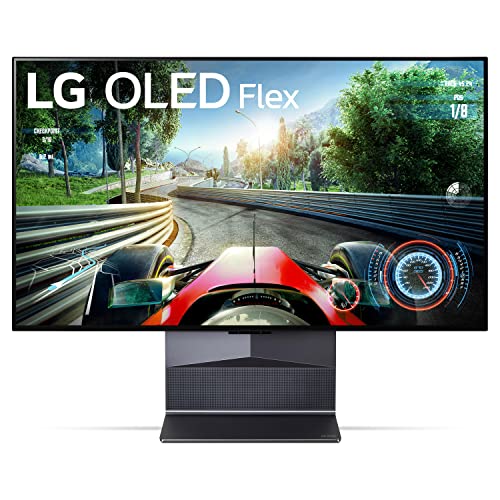
True Score
87872Experts
9313Customers
Absolutely Fresh

Snapshot
Reasons to Buy
- Exceptional picture quality
- Impressive brightness and contrast
- Variable Refresh Rate support
- Exceptional reflection handling
- Incredible response time
Reasons to Avoid
- Limited height adjustment and no VESA support
- Adjustable screen reverts to a flat position when off
- Risk of permanent burn-in
- Limited height adjustment and no VESA support
- The glossy display may cause reflections in bright lighting conditions
- Screen reverts to a flat position when off, which can be inconvenient
- The price may be high for some consumers
Specifications
Max Resolution 3840 x 2160 (4k) 
Backlight Type Full-Array Refresh Rate 120 Hz Display Type OLED HDMI Inputs 4 HDR Format Dolby Vision, HDR10, HLG 
LED Panel Type OLED Screen size 42″ 
Smart Platform webOS 
Sync Technology AMD FreeSync, G-Sync 
VRR Yes All Specs
Test Results
SDR Brightness (nits) 374 HDR Brightness (nits) 738 Color Gamut % (DCI P3 xy) 97.92 Response Time (ms) 2.5 Contrast Ratio (x:1) 0 EOTF (600 nit delta) 0.0028 Color Gamut % (DCI P3 uv) 99.19 Color Gamut % (Rec 2020 xy) 71.3 Color Gamut % (Rec 2020 uv) 74.64 Color Gamut % (sRGB) 0 Color Gamut % (Rec 709) 0 Color Gamut % (BT.2020) 0 Color Gamut % (Adobe RGB) 0 Color Gamut % (BT.709) 0 Input Lag (ms) 10 Color Washout (Degrees) 52 Color Shift (Degrees) 28 Brightness Loss (Degrees) 69 Reflections (%) 0.9 Low-Freq Extension (Hz) 113.14 Freq Response StdDev @ 70db 2.74 Freq Response StdDev @ 80db 2.83 Weighted Total Harmonic Distortion @80db 0.034 Intermodulation Distortion @80db 1.95 EOTF (1000 nit delta) 0.0024 EOTF (4000 nit delta) 0.0025 All Tests
All Retailers
Our Verdict
If you need a TV that can pull double duty as a monitor, the Flex OLED’s unique ability to bend may be enough to justify the premium price tag. The ability to curve the screen for a more immersive gaming or cinematic experience is largely the reason the TV’s price tag is so high, and because of it, the Flex offers a tailored viewing experience that can enhance the immersion and focus for gamers and movie enthusiasts alike.
Its color gamut coverage of 97.92% means the Flex is no slouch when it comes to accurately rendering colors, but it has the same faults the B3 does when it comes to brightness. Its SDR and HDR brightness levels of 374 and 738 nits respectively keep it firmly in dim and moderately lit spaces, though given its ability to act as a monitor, it’s more suited to sit on a desk or dresser than hang on a wall in a well lit room. With a response time of 2.5 ms and an input lag of 10.0 ms, the Flex OLED is also well-suited for gaming and watching sports. With the second best response time out of all the LG TVs on our list, the Flex is an especially good choice for someone that needs a sports TV and a monitor in the same package.
Cinephles looking for that extra level of immersion will enjoy the Flex’s low EOTF of 0.0028, coming in just 0.0001 behind the G3, making the Flex an incredible choice for extremely accurate movie content. Its viewing angles are worse, but it’s also significantly smaller and therefore better suited to having less people watch it.
That size difference, however, is both a benefit and a detriment. While it’s easier to get the Flex into tighter spaces or sit it on a desk, it also has the highest price tag on the entire list. You’re paying more for less screen real estate with the Flex, which means the flexibility of the screen needs to be the driving motivator behind any purchase decision. If a bendable screen, excellent responsiveness and color accuracy are enough to offset the premium price tag and middling brightness, the Flex might be what you need, otherwise, the similarly priced G3 will get you more of everything – including screen size – at a lower price.

Best Overall

Runner Up

Best Value

Best Budget

Best Mid-Range

Premium Pick
LG B3 OLED TV
Offering outstanding value, the LG B3 balances cost and OLED quality, ideal for budget-conscious enthusiasts seeking deep blacks and vivid colors.
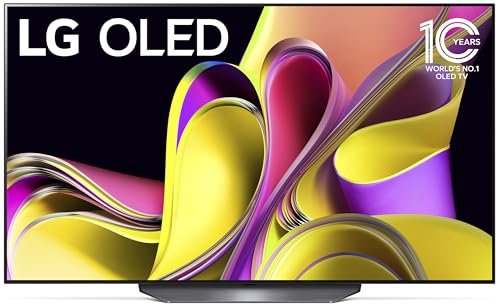
True Score
87874Experts
922kCustomers
Absolutely Fresh
 SAVE $90$1,186.95$1,096.95
SAVE $90$1,186.95$1,096.95Snapshot
Reasons to Buy
- Excellent picture quality
- Great Contrast
- High-performance motion handling
- Fast refresh rate
- Wide Viewing Angles
Reasons to Avoid
- Below Average Brightness
- Aggressive ABL
- Mediocre speaker sound quality
Specifications
Max Resolution 3840 x 2160 (4k) 
Backlight Type n/a Refresh Rate 120 Hz Display Type OLED HDMI Inputs 4 
HDMI Type HDMI 2.1 HDR Format Dolby Vision 
HomeKit Compatible Yes 
Number of Audio Channels 2.1 
Panel Type OLED Screen size 55″, 65″, 77″ 
Smart Platform webOS 
Speaker Output 20 Watts 
Sync Technology AMD FreeSync Premium, G-Sync 
VRR Yes All Specs
Test Results
SDR Brightness (nits) 390 HDR Brightness (nits) 617 Color Gamut % (DCI P3 xy) 98.345 Response Time (ms) 3.1 Contrast Ratio (x:1) 0 EOTF (600 nit delta) 0.0067 Color Gamut % (DCI P3 uv) 99.62 Color Gamut % (Rec 2020 xy) 73.09 Color Gamut % (Rec 2020 uv) 77.66 Color Gamut % (sRGB) 0 Color Gamut % (Rec 709) 0 Color Gamut % (BT.2020) 73.14 Color Gamut % (Adobe RGB) 0 Color Gamut % (BT.709) 0 Input Lag (ms) 11.7 Color Washout (Degrees) 64 Color Shift (Degrees) 31 Brightness Loss (Degrees) 70 Reflections (%) 1.4 Low-Freq Extension (Hz) 84.76 Freq Response StdDev @ 70db 3.64 Freq Response StdDev @ 80db 3.67 Weighted Total Harmonic Distortion @80db 0.165 Intermodulation Distortion @80db 8.25 EOTF (1000 nit delta) 0.0035 EOTF (4000 nit delta) 0.0037 All Tests
All Retailers
- $1,096.95$1,187Save $90
Availability
In StockFree Shipping
No - $1,099.00$2,400Save $1,301
Availability
In StockFree Shipping
No - $1,196.99$2,397Save $1
Availability
In StockFree Shipping
- $1,199.99$1,300Save $100
Availability
In StockFree Shipping
No
Our Verdict
The LG B3 OLED TV is one of the best value TVs within LG’s premium lineup, providing OLED performance and features, like true blacks and near-infinite contrast, at a price point that’s accessible. Despite its positioning as a more budget set, its specifications and test results highlight its strengths in several areas, making it a worthy consideration if you’re looking to enjoy OLED quality without OLED prices.
Featuring a DCI P3 xy color gamut coverage of 98.35%, the LG B3 slightly trails the LG C3 in color accuracy but still ensures rich and vivid color reproduction for an engaging viewing experience. Its SDR and HDR brightness levels, at 390 and 617 nits respectively, are sufficient for most home viewing conditions, but the set will struggle in bright rooms. The B3’s response time of 3.1 ms and an input lag of 11.7 ms position it as a fantastic choice for sports and a good choice for gaming, offering excellent performance in competitive games and blur-free visuals for sports fans.
With an EOTF of 0.0067, the B3 is overall the lowest performing on the list when it comes to gamma accuracy, but it still clears our minimums by more than 0.01, which means it’s still an excellent option for movie buffs. While it’s not great in brighter rooms because of its lower brightness, it still gets the job done in dimly lit home theaters without sacrificing quality.
Overall, the B3 holds its ground as a versatile performer capable of handling most content with ease. The TV does a fantastic job of a well-rounded, affordable package that offers up the rich contrast and deep blacks of OLED panels without having to break the bank. If value is what matters most, the B3’s runner-up position is not only obvious, but deserved.

Best Overall

Runner Up

Best Value

Best Budget

Best Mid-Range

Premium Pick
LG C3 OLED TV
With superior color accuracy and gaming performance, the LG C3 delivers a balanced high-quality experience, though it’s outshined by the G3 in brightness.
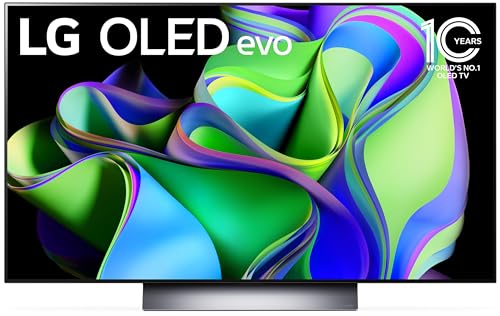
True Score
87869Experts
9310kCustomers
Absolutely Fresh
 SAVE $273$1,499.99$1,226.99
SAVE $273$1,499.99$1,226.99Snapshot
Reasons to Buy
- Excellent picture quality
- The near-infinite contrast ratio for perfect blacks
- Strong peak brightness
- High-performance motion handling
- Fast refresh rate
Reasons to Avoid
- Aggressive automatic brightness limiter
- Subpar sound quality
Specifications
Max Resolution 3840 x 2160 (4k) 
Backlight Type No Refresh Rate 120 Hz Display Type OLED HDMI Inputs 4 
HDMI Type HDMI 2.1 HDR Format Dolby Vision, HDR10, HLG 
HomeKit Compatible Yes 
LED Panel Type WOLED 
Number of Audio Channels 7.1.2 
Panel Type – Screen size 42″, 48″, 55″, 65″, 75″, 83″ 
Smart Platform webOS 
Speaker Output 20 Watts 
Sync Technology AMD FreeSync Premium, G-Sync 
VRR Yes All Specs
Test Results
SDR Brightness (nits) 383 HDR Brightness (nits) 795 Color Gamut % (DCI P3 xy) 98.98 Response Time (ms) 2.3 Contrast Ratio (x:1) 0 EOTF (600 nit delta) 0.0056 Color Gamut % (DCI P3 uv) 99.51 Color Gamut % (Rec 2020 xy) 73.28 Color Gamut % (Rec 2020 uv) 76.01 Color Gamut % (sRGB) 0 Color Gamut % (Rec 709) 0 Color Gamut % (BT.2020) 74.7 Color Gamut % (Adobe RGB) 0 Color Gamut % (BT.709) 0 Input Lag (ms) 9.6 Color Washout (Degrees) 63 Color Shift (Degrees) 34 Brightness Loss (Degrees) 70 Reflections (%) 1.1 Low-Freq Extension (Hz) 80 Freq Response StdDev @ 70db 1.14 Freq Response StdDev @ 80db 1.98 Weighted Total Harmonic Distortion @80db 0.085 Intermodulation Distortion @80db 4.49 EOTF (1000 nit delta) 0.0054 EOTF (4000 nit delta) 0.0051 All Tests
All Retailers
- $1,226.99$1,500Save $273
Availability
In StockFree Shipping
No - $1,296.99$2,500Save $1,203
Availability
In StockFree Shipping
No - $1,299.99$1,600Save $300
Availability
In StockFree Shipping
No - $1,596.99$2,497Save $900
Availability
In StockFree Shipping
Our Verdict
If you’re looking for a solidly mid-range TV, the LG C3 is basically the midpoint between the G3 and B3, and offers a strong mix of features and value for its price point. It stands out with a DCI P3 xy color gamut coverage of 98.98%, the highest among its peers, ensuring vibrant and accurate color reproduction for an immersive viewing experience.
Combined with its SDR and HDR brightness levels of 383 and 795 nits respectively, makes it well-suited for various lighting conditions, though it does not reach the peak brightness levels of the LG G3. Its response time of 2.3 ms and low input lag of 9.6 ms also make it an ideal candidate for gamers looking for swift and responsive display performance.
The C3 offers better performance in key areas over the B3, such as color gamut coverage and input lag, justifying its higher price. Similarly, when placed against the LG G3, the C3 doesn’t shine as brightly in terms of SDR and HDR brightness but, if you’re a cinephile or sports fan, the C3 maintains its competitive edge with superior color accuracy and faster response times at a cheaper price.
The LG C3 OLED TV’s balanced performance across various test criteria makes it a versatile choice. It excels in delivering high-quality home theater experiences, gaming, and viewing in dim and moderately lit rooms thanks to its color accuracy, response time, and input lag. In LG’s overall lineup, it’s a strong contender if you’re looking for a high-quality OLED TV that’s one step above entry-level but not quite top shelf.

Our Approach to Testing LG TVs
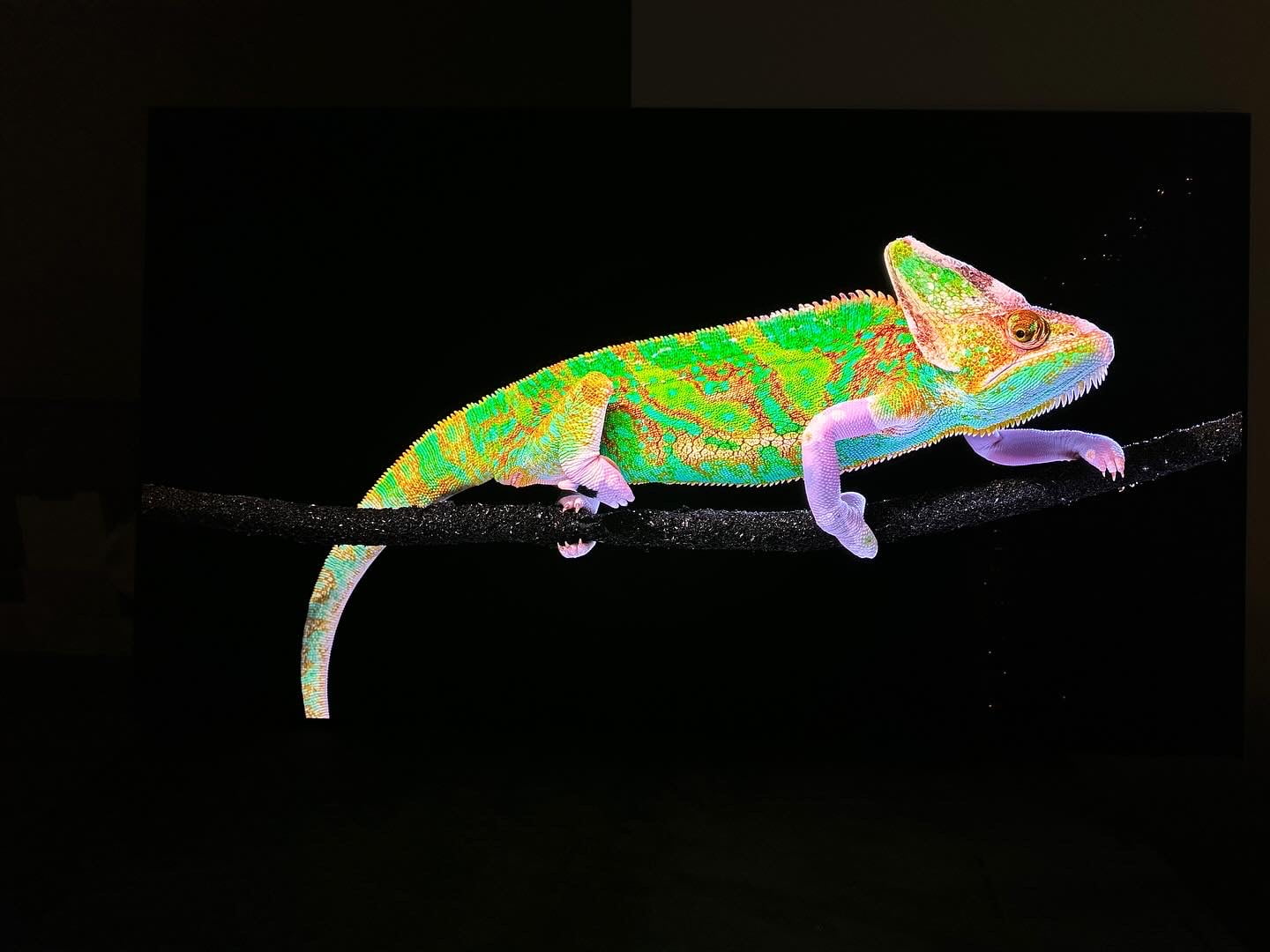
Evan Shepard/Gadget Review
We’ve redefined TV buying guides, setting us apart from any other site on the planet. Our unique approach uses a comprehensive dataset from trusted sites, focusing on key testing metrics like brightness (SDR and HDR), EOTF, response time, contrast ratio and color gamut.
We aggregate and analyze this data, ensuring our recommendations meet the specific needs. Specifically, when it comes to LG TVs, this involves selecting models that deliver optimal image quality, including the ability to upscale lower-resolution content effectively. Discover our data-driven methodology for precise, reliable TV recommendations.
You may notice some of our graphs contain “Source: RTings”. This is to indicate that the data we’re showing off in a graph has come from a single source – because it’s the only source that actually tested the criteria and had data for it! Normally, our data is an average out of all of the various publications that test and provide data to give you a good idea of how a product is going to perform on average.
Which Criteria Matters for Testing Best LG TVs?
By focusing on these criteria (3 required, 3 nice to have), anyone can quickly and easily compare these TVs and how they’ll perform. This helps you make an informed decision and purchase a TV that will fit into your space.
| CRITERIA | RANGE | REQUIRED | DEFINITION |
|---|---|---|---|
| SDR Brightness | 300+ nits | Yes | Assess the luminance of your display when operating in Standard Dynamic Range (SDR) mode. |
| HDR Brightness | 600+ nits | Yes | Determine the luminance of your display in High Dynamic Range (HDR) mode. |
| Color Gamut (DCI P3 xy) | >= 90% | Yes | Evaluate the extent to which a TV can reproduce a specified spectrum of colors. |
| EOTF | 0.018 | No (nice to have) | Standard that governs how a display interprets and renders brightness and color. |
| Response Time | <=10ms | No (nice to have) | Time required for a pixel to transition from one color to another and then return to its original color. |
| Contrast Ratio | >= 10,000 | No (nice to have) | The ratio between the brightest white and darkest black that the screen can display. |
Our Trusted Data Sources
(Publication category Score is 80%+)
We looked at 210+ TV reviewers and while 24 are trustworthy (60%+ Trust Rating), we only use data from the testers that are “very trusted” which means a Trust Rating above 70%. The three we have listed below are our most trusted for TVs, along with our own in-house TV expert.
- Evan Shepard – Gadget Review
- Matthew Lopes – RTings, MuckRack
- Will Greenwald – PCMag, MuckRack, Twitter
- David Katzmaier – CNET, MuckRack, Twitter
Interested in a comprehensive analysis of our data sources? We’ve got you covered. Below, you’ll find a detailed list of every TV review website we’ve identified, organized by their respective Trust Ratings from highest to lowest. But we didn’t stop there. We’ve meticulously reviewed each publication and verified the data by checking whether the authors have bio links to MuckRack or LinkedIn. We’re committed to not only checking the facts but ensuring their veracity.
Best LG TVs Test Data & Results
1. SDR & HDR Brightness TV Test Results
In well-lit rooms, the brightness level of your LG TV, quantified in nits, is key to a great viewing experience. A TV that doesn’t meet the brightness requirement will struggle against natural and artificial light, resulting in a dim, lackluster image. Essentially, nits measure how well your TV can stand up to light interference, with higher values ensuring a sharper, more vivid display.
For standard viewing on the best LG TV, you should look for at least 300 nits to strike the right balance between clarity and color quality in standard dynamic range (SDR) content. For high dynamic range (HDR) content, which offers richer colors and greater contrast, a minimum of 600 nits is ideal to truly appreciate the enhanced visuals. These brightness levels are recommended to ensure your TV performs well in bright settings, allowing you to enjoy your shows and movies without any loss in detail or quality. Aim for these minimums: SDR Brightness >= 300 nits; HDR Brightness >= 600 nits for the optimal experience.
Discover the top LG TVs, ranked from brightest to least.
Brightness
SDR: 300+ nits
HDR: 600+ nits
Acceptable range of performance
Definition: Maximum brightness in a specified pattern size window. Most commonly measured in a 10% or 100% white window.
Units of Measurement: nits (alternatively cd/m²)
Tools to Measure: TV, luminance meter
Why It’s Important:
Brightness helps counter ambient light so that details and colors don’t wash out and get lost.
SDR Brightness (in nits, higher is better)
HDR Brightness (in nits, higher is better)
2. Color Gamut (DCI P3 xy) TV Test Results
Color Gamut
>= 90%
Acceptable range of performance
Definition: The TV’s capability to display a spectrum of colors.
Units of Measurement: % (color space coverage in percent)
Tools to Measure: Colorimeter
Why It’s Important:
Inaccurate colors compromise the authenticity of the content.
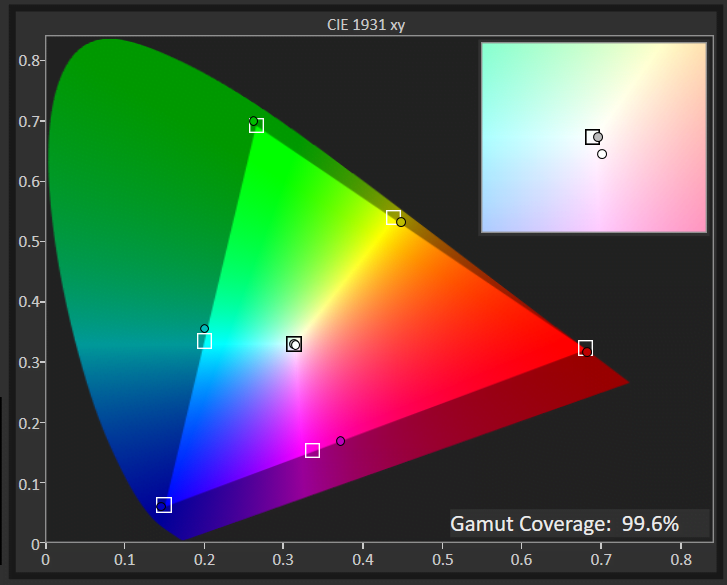
Color gamut defines the range of colors a LG TV can reproduce, directly affecting how vibrant and true-to-life the images look. A wide color gamut in a TV brings out richer, more vivid colors – from the lush greens of a garden to the bright colors of animated characters, enhancing your viewing experience to closely mimic real life.
This concept is technically measured against standards like the DCI P3 xy, a benchmark for high-quality visuals. A LG TV covering a higher percentage of this color space can display colors more accurately and vividly.
For those who prioritize vibrant and immersive visuals, aiming for a LG TV with a color gamut of 90% or higher on the DCI P3 xy scale is ideal. This ensures that the content you watch is as vibrant and lifelike as possible.
Below are the top LG TVs, ordered by color gamut, all exceeding our testing criteria.
DCI P3 XY Color Gamut (as a %; high is better)
3. EOTF Test Results
The Electro-Optical Transfer Function (EOTF) plays a critical role in ensuring the content on your TV looks exactly as the creator intended. This technical feature adjusts your screen’s brightness levels, ensuring every scene, from the darkest shadows to the brightest highlights, is displayed with true-to-life accuracy.
In rooms flooded with light, a TV that nails EOTF calibration shines by preserving the intended contrast and detail in the picture despite the challenging conditions. It balances the brightness so that images remain vibrant and full of detail, unaffected by the glare of ambient light.
A TV that excels in managing EOTF offers an immersive and authentic viewing experience. It brings creators’ visions to life, accurately rendering every scene with the proper light and dark levels, no matter the lighting in your room. This means you get a consistent, realistic picture that captures the full spectrum of colors and contrasts, from the subtlest hues to the most intense explosions.
Below are all the LG TVs on our list, ordered by EOTF, all exceeding our minimum requirement.
EOTF
< 0.018 (600 nit Δ)
Acceptable range of performance
Definition: How your TV interprets and renders the luminance data from content and translates it to be represented on screen. If EOTF/Gamma tracking is too low or too high, it will result in an over-brightened or over-darkened image from reference.
Units of Measurement: this test measures for the delta from the standard
Tools to Measure: Luminance colorimeter
Why It’s Important:
EOTF ensures that the game is displayed (color and HDR brightness) as the creator intended it
EOTF (source: rtings.com – 0 = no data exists; lower is better)
4. Response Time TV Test Results
Response Time
1ms-10ms
Acceptable range of performance
Definition: Speed at which a pixel transitions from one color to another
Units of Measurement: milliseconds (ms)
Tools to Measure: Screen, camera, test software
Why It’s Important:
A faster response time means less blur and thus more accuracy
A slow response time on a LG TV during fast-paced scenes is like trying to watch a thrilling movie with a foggy lens. Imagine settling in for an action-packed sequence, only to have the swift movements turn into a blur, robbing you of the crisp, clear detail you crave. This isn’t just a minor annoyance; it’s a major detriment to your viewing experience, leaving you with a picture marred by motion blur and visual artifacts.
So, what exactly is response time? It measures how quickly a pixel on your TV can change from one color to another. In the context of watching fast-moving content or enjoying dynamic scenes on a LG TV, a low response time is crucial. A response time of 15 ms or lower is good, but if you plan on gaming on this set, aim for a response time of 10 ms or lower. At these levels, your LG TV ensures smooth transitions and sharp visuals, making every scene come to life without any distracting blurs or delays.
Below are the top LG TVs, ordered by response time, all exceeding our testing criteria.
Response Time (in milliseconds; lower is better)
5. Contrast Ratio Test Results
For LG TV enthusiasts, a solid contrast ratio is crucial for enjoying your favorite TV shows or movies, especially in darker settings. This feature directly impacts how lifelike and dynamic the picture appears on your screen, ensuring that dark scenes are displayed with clear, crisp blacks instead of murky grays and bright scenes retain their detail without appearing washed out.
Put simply, the contrast ratio is all about the range of luminance a TV can produce, from the deepest blacks to the brightest whites. It’s what brings depth to the image, enhancing the realism of every scene. Watching a movie in the dark, for example, the difference between a TV with a poor contrast ratio and one with a high ratio is stark: the former struggles, blending shadows into a flat gray, while the latter delivers true black, making night scenes more immersive and detailed.
Ideally, a contrast ratio of 10,000:1 is what you should aim for in a LG TV. This level of luminance variance ensures that you’re getting a picture quality that can handle the nuances of lighting in any scene, providing a viewing experience that’s both rich and engaging. Note: OLED TVs have infinite contrast ratio, indicated by “0.”
Below are the top LG TVs, ordered by contrast ratio, all exceeding our testing criteria.
Contrast Ratio
>=10,000:1
Acceptable range of performance
Definition: Difference between the darkest black and the brightest white a screen can display.
Units of Measurement: cd/m2
Tools to Measure: Luminance meter
Why It’s Important:
A higher contrast ratio delivers deeper blacks, enhancing content definition, especially in darker rooms.
Contrast Ratio (higher is better)
Best LG TVs: Mistakes To Avoid
- Ignoring Screen Size: Overlooking the appropriate screen size for your viewing distance and room dimensions can lead to dissatisfaction with the viewing experience. For larger rooms where the couch is placed far from the TV, 80-inch TVs can be an ideal choice, ensuring that the screen fills your field of view for an immersive experience.
- Neglecting Display Technology: Failing to research and understand different display technologies (such as OLED vs. LED) can result in choosing a TV that doesn’t meet your needs or preferences. To ensure an informed decision, looking into the best OLED TVs can clarify why this technology might be preferable for your specific viewing habits. Read our LG BX OLED review for a model that is suitable for various content types, from gaming to cinematic experiences.
- Not Considering Connectivity: Overlooking the importance of available ports and connectivity options can limit your ability to connect external devices or accessories. When looking for the best gaming TVs, you need to pay attention to their connectivity features to ensure they can accommodate a soundbar, gaming console, and other peripherals without hassle. If you are considering a soundbar be sure to learn how to connect a soundbar to your TV to enhance your audio experience.
- Disregarding Picture Quality: Not prioritizing factors like resolution, refresh rate, HDR capabilities, and color accuracy can lead to a subpar viewing experience. Understanding the differences in resolution, such as in a 4K vs 8K comparison, is crucial in appreciating what these advanced displays have to offer in terms of picture quality. While 4K TVs provide excellent clarity and detail for most content, the best 8K TVs offer a future-proof option for enthusiasts seeking the ultimate in resolution and image precision.
The Best LG TVs Tests Compared
Product |
True Score
|
SDR Brightness
|
HDR Brightness
|
Color Gamut
|
EOTF
|
Response Time
|
Contrast Ratio
| |
|---|---|---|---|---|---|---|---|---|
| 90 |
|
|
|
|
|
| $1,846.95 $2,797 $950 |
| 87 |
|
|
|
|
|
| |
| 87 |
|
|
|
|
|
| $1,096.95 $1,187 $90 |
| 87 |
|
|
|
|
|
| $1,226.99 $1,500 $273 |

